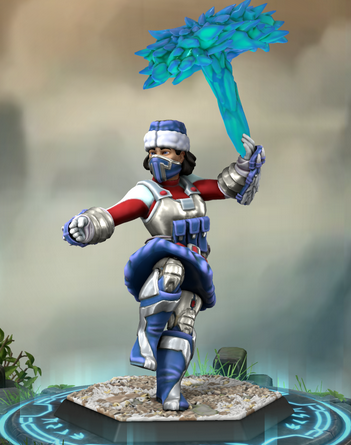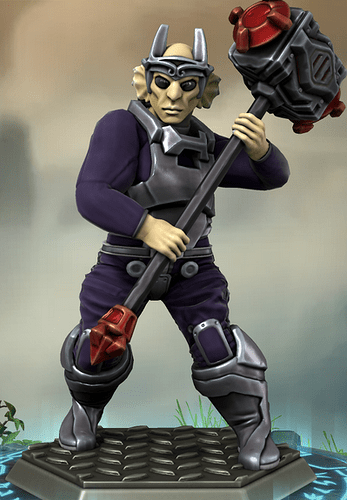Motherland
Real Name: Sonya Kuragin, First Appearance: Hidden Champions (Vol. 2) #16, June 2015
Approach: Focused, Archetype: Invader
Upgrade: Quality Upgrade I, Mastery: Superiority
Status Dice: Based on environment minions, lieutenants, and challenges. None: d10. 1-2: d8. 3+: d6. Health: 15+5H
Qualities: Ranged Combat d10, Leadership d8, Super-Soldier d8
Powers: Cold d12, Presence d8
Abilities:
- Frostmaiden (I): Ignore all Cold damage.
- Winter’s Touch [A]: Hinder one target using Cold. Use your Max die. Attack that target using your Mid die.
- Spirit of the Motherland [A]: Defend yourself using Presence. This Defend lasts until your next turn. If an Attack deals more damage than the Defend’s value, end the Defend and Boost all of your allies equal to the Defend.
- Collateral Damage [A]: Overcome using Cold. Use your Max die. Attack an environment target with your Mid die. Attack any target with your Min die.
- Hidden Loyalists [A]: Boost using Leadership. Use your Max die. One environment minion becomes a villain minion. It acts at the start of your turn.
- Redirect Fire [R]: When the environment targets you with an Attack or Hinder, redirect it to a hero or environment target.
Common Scene Elements:
- Imperial Loyalists. D8 minions. Imperial Loyalists have +1 to saves.
- Winter Guard. D8 lieutenants. Winter Warriors have +1 to Attacks using cold and +1 to saves against cold.
- Hostile Territory. A government facility or civic centre that Motherland intends to bring down.
With the restoration and expansion of the Champions of Truth at the end of 2010, the writers of the line found that they had a new problem - aside from Skybreaker, who still had his own comic, the cast had grown large enough that individual members didn’t have time for much in the way of solo stories or growth. After running limited series focusing on the Champions’ major members for a few years, Hidden Champions (Vol. 2) debuted at the end of 2014. The line’s premise was to have one, or occasionally two, of the major Champions other than Skybreaker teaming up with other Venture Comics heroes (especially those currently lacking a title and those with pre-existing ties) in order to take on challenges suited to their individual natures.
The title was a strong success, running through to early 2019, but it didn’t debut very many villains. Usually, it was a chance to revive foes who hadn’t hit the page in a long time. One of the few enduring characters created for the page, however, was Motherland.
Sonya Kuragin was a Russian military officer and fervent believer in the nationalist dream. She had grown up in the dying days of communism, trained by her fanatical father Lockstep, but had seen her dreams turn to ash before she was old enough to fight for them. As she grew up through the fall of post-Soviet Russia, she became increasingly frustrated at the state of her world, and ultimately decided to do something about it. Against her father’s wishes, she volunteered for one of the last experimental Russian super-science programs, letting herself be turned into an incarnation of the Russian winter.
Having finally gained the power to fight, Sonya became Motherland - the epitome of Russian nationalism and violent fervour. She quickly took control of the installation she had volunteered at, running more soldiers through the experiments to turn the survivors into her Winter Guard, and attacked a nuclear facility with the goal of setting off a nuclear winter that she believed only the strongest Russians would survive. She hoped to use her powers to protect her followers and rebuild in the devastated world to follow.
Madame Liberty joined forces with her old Covert Tactics ally Big Brain to try and reach the facility before Motherland could finish conquering it. They were joined by an unlikely ally - Sonya’s own father. Lockstep blamed himself for training his daughter to be a monster. He couldn’t make her see reason, so he resolved to stop her at any cost to himself. Together, the three saved the world, but the Winter Guard sacrificed themselves so that Motherland could escape to rebuild Russia anew.
Over the next few years, Motherland would make appearances in both Champions of Truth and in Gale Force, in which she allied with Vortex and Gale Force allied with Lockstep. The two were dark mirrors of each other, despite not having been designed as foes, and soon Motherland was seen as more of a Gale Force nemesis than one for Madame Liberty.
Behind the Scenes
I accidentally made a second Gale Force enemy.
I’d planned on Motherland after discussion about Lockstep and his potential kids; the idea of a supervillain raising his daughter to be a better supervillain than him, but then being filled with regret and trying to stop her from going too far, was a juicy story. Since Lockstep was primarily a Madame Liberty / Covert Tactics villain, he seemed like a good character to include with Madame Liberty and a Covert Tactics hero to fight his daughter. But then I was deciding where else she appeared, and the parallels between her and Gale Force became way too obvious to ignore. So that’s how she gets her footing and endures. Post-timeskip, she probably is primarily an Earthwatch villain, with occasional runs at the Champions of Truth.



